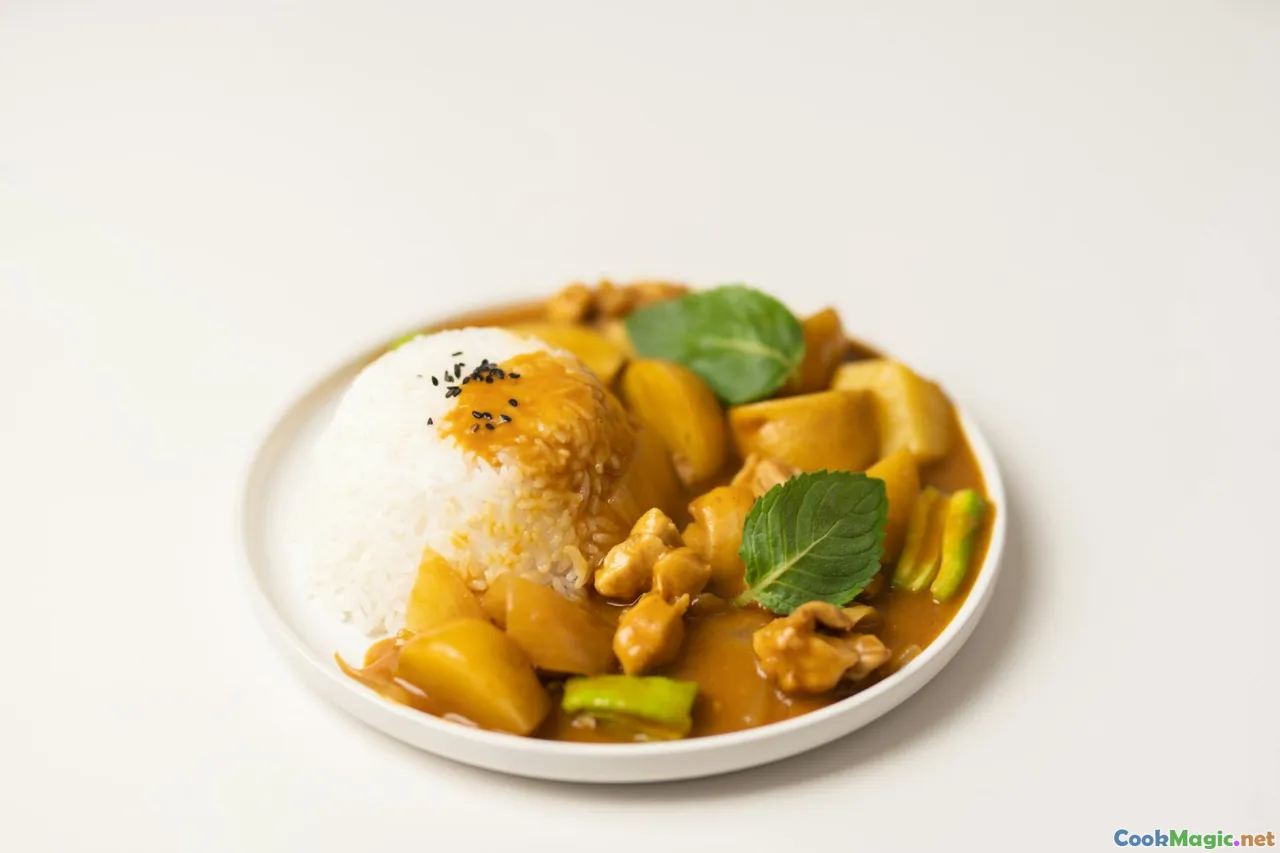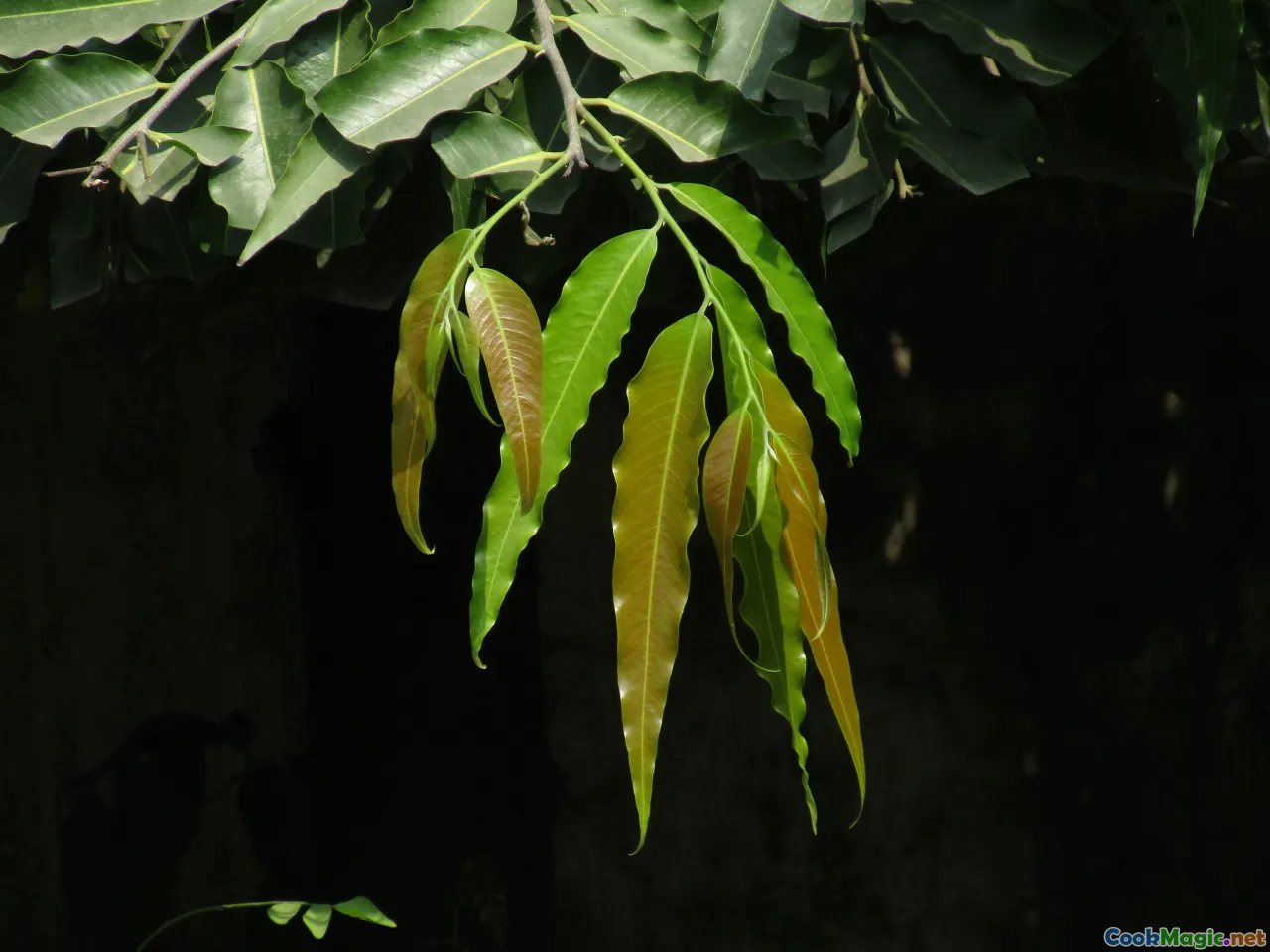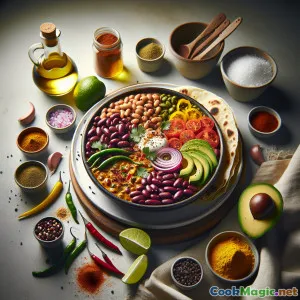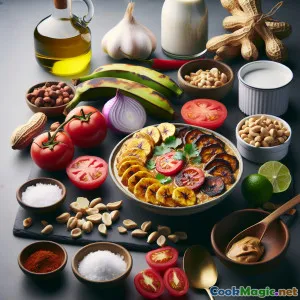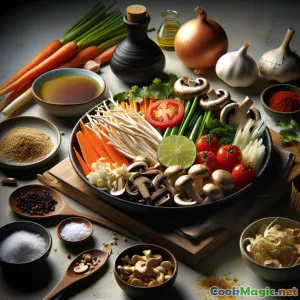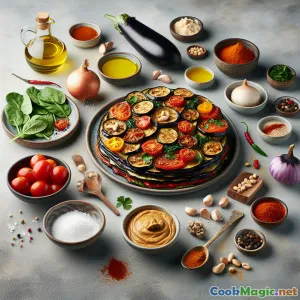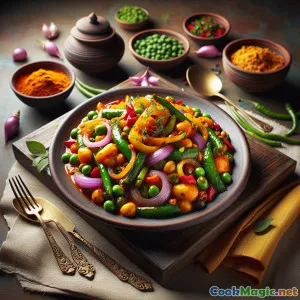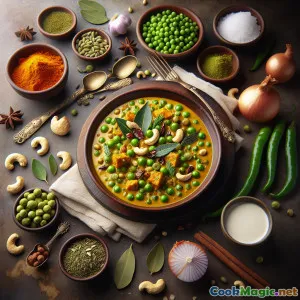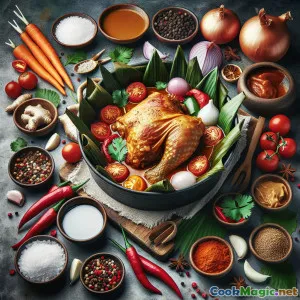
Восхитительное блюдо — курица Лувомбо, завернутая в банановые листья
(Banana Leaf-Wrapped Luwombo Chicken Delight)
(0 Обзоры)0
855
июль 20, 2025
Сообщить о проблеме
Ингредиенты
-
800 grams Куриные бедра (с косточкой, без кожи)
(нарезать крупными кусками)
-
4 sheets Банановые листья
(Large, split into 35x35cm squares; rinsed and softened over flame)
-
3 medium Помидоры
(Fresh and ripe, diced)
-
1 large Лук
(Мелко нарезанный)
-
4 pieces Чесночные зубчики
(Измельченный)
-
1 tbsp Имбирь
(Тёртый)
-
2 medium Морковь
(Тонко нарезанный)
-
1 large Красный болгарский перец
(Жюльен)
-
3 tbsp Арахисовая паста (без сахара)
(Traditional Luwombo sauce base)
-
200 ml Кокосовое молоко
(Full fat for creamy richness)
-
2 tbsp Растительное масло
(Для обжаривания)
-
1.5 tsp Соль
-
0.5 tsp Чёрный перец
-
200 ml куриный бульон
(Низкое содержание натрия)
-
1 small bunch Свежая кинза (кориандр)
(Мелко нарезанный, для подачи)
-
0.5 piece Перец Scotch bonnet
(Finely chopped, for authentic East African heat)
(нарезать крупными кусками)
(Large, split into 35x35cm squares; rinsed and softened over flame)
(Fresh and ripe, diced)
(Мелко нарезанный)
(Измельченный)
(Тёртый)
(Тонко нарезанный)
(Жюльен)
(Traditional Luwombo sauce base)
(Full fat for creamy richness)
(Для обжаривания)
(Низкое содержание натрия)
(Мелко нарезанный, для подачи)
(Finely chopped, for authentic East African heat)
Питательная ценность
- Порции: 4
- Размер порции: 1 wrapped parcel (approx. 300g)
- Calories: 540 kcal
- Carbohydrates: 0 g
- Protein: 34 g
- Fat: 34 g
- Fiber: 6 g
- Sugar: 7 g
- Sodium: 850 mg
- Cholesterol: 120 mg
- Calcium: 70 mg
- Iron: 2.2 mg
Инструкции
-
1 - Prep banana leaves:
Pass banana leaves over an open flame or boiling water for a few seconds until wilted and flexible. Wipe clean and set aside.
-
2 - Marinate Chicken:
Mix chicken pieces with salt, half of the black pepper, and ginger. Let sit while prepping the vegetables.
-
3 - Sauté veggies and aromatics:
In a skillet, heat oil. Sauté onions until translucent. Add garlic, tomatoes, bell pepper, and carrots. Sauté for 5 minutes until softened.
-
4 - Prepare masala paste:
Stir in peanut butter with veggie mix, followed by coconut milk (if using) and stock. Cook gently until smooth and fragrant.
-
5 - Assemble Wraps:
Place each banana leaf glossy-side up. Spoon a portion of the veggie sauce in the center, top with two chicken pieces (and some chili if using), and wrap tightly. Secure with short strings or kitchen twine.
-
6 - Steam Parcels:
Set wrapped parcels in a steamer above simmering water. Steam for 50 minutes until chicken is thoroughly cooked and flavors penetrate.
-
7 - Rest & Serve:
Let parcels rest for 5 minutes. Unwrap and garnish with chopped coriander. Serve with steamed rice, matoke, or yams.
Pass banana leaves over an open flame or boiling water for a few seconds until wilted and flexible. Wipe clean and set aside.
Mix chicken pieces with salt, half of the black pepper, and ginger. Let sit while prepping the vegetables.
In a skillet, heat oil. Sauté onions until translucent. Add garlic, tomatoes, bell pepper, and carrots. Sauté for 5 minutes until softened.
Stir in peanut butter with veggie mix, followed by coconut milk (if using) and stock. Cook gently until smooth and fragrant.
Place each banana leaf glossy-side up. Spoon a portion of the veggie sauce in the center, top with two chicken pieces (and some chili if using), and wrap tightly. Secure with short strings or kitchen twine.
Set wrapped parcels in a steamer above simmering water. Steam for 50 minutes until chicken is thoroughly cooked and flavors penetrate.
Let parcels rest for 5 minutes. Unwrap and garnish with chopped coriander. Serve with steamed rice, matoke, or yams.
Подробнее о: Восхитительное блюдо — курица Лувомбо, завернутая в банановые листья
All About Luwombo Chicken Wrapped in Banana Leaves
Luwombo is Uganda’s best-kept culinary secret—a traditional celebratory dish as impressive in flavor as it is stunning in its natural presentation. The word luwombo refers not just to the stew but to the ingenious method of slow-cooking delicate meats, vegetables, and nuts inside a wrap of fresh banana leaves. This heritage cooking method seals in extraordinary moisture and fragrance, while honoring a deeply rooted cultural relationship with local, earth-friendly produce.
History & Significance
The origins of luwombo stretch back to the royal kitchens of the Buganda Kingdom over a century ago. Delicately flavoured chicken, beef, or mushrooms are combined with groundnut (peanut) sauce, then compressed ingeniously inside banana leaf parcels. Luwombo, treasured for weddings and festivals, became a symbol of generosity and skillful home cooking across Uganda. Traditionally, women would prepare the sauce and meats, then the house elder—often a grandmother—would assemble the wraps in a communal setting, passing down knowledge and preserving flavor memories for the next generation.
Technique Tips
Mastering luwombo’s wrap is both a craft and an experience! The key is in preparing the banana leaves: they must be gently passed over heat until glossy and flexible—not brittle. This ensures the parcel seals in juices but holds strong when steamed for up to an hour. The peanut groundnut sauce is the heart of the aroma—choose pure, unsweetened peanut butter to respect tradition and layer with coconut if you’d like a modern creamy touch.
When the tightly-bound parcels are steamed, magic happens: the banana leaves lend their herby fragrance, infusing everything inside. Any leftover leaves may be composted, in true sustainable spirit. You’ll savor flavors richer—and healthier—than ordinary stews due to the gentle, oil-reducing steaming technique.
Serving Style
Unlike other stews, the unveiling or unwrapping is part of the tradition—a moment of communal joy as everyone peels open the parcel and shares in the thrill of the escaped steam. Serve best with matoke (Uganda’s starch staple: steamed and mashed green bananas), steamed rice, or yams. A cold glass of sour passion fruit juice or fresh fruit on the side are ideal accompaniments.
Unique Aspects & Variations
Luwombo can be made vegetarian (with mushrooms) or beef-based; peanut is the preferred thickener, but cashews or sunflower seeds innovate nicely. The recipe above features coconut for a cross-cultural twist—try omitting it for an even more traditional version! Scotch bonnet chili elevates the authentic East African kick but can always be left out for milder tastes. Customarily, chicken legs or thighs are used for deep flavor, but mixed pieces work so long as they’re juicy and not dried out by extended steaming.
Personal Notes
Making luwombo didn’t just wow my senses—it offered a window into Ugandan homes, where food is far more than fuel—it’s a celebration of seasonal ingredients and neighborly labor. With practice, wrapping becomes meditative—a gift you hand someone on a plate, both humble and regal. Serve luwombo chicken wrapped in banana leaves at your next festive meal, and you’ll deliver a story every bit as compelling as the deep, nutty scent that rises from the unveiling!

